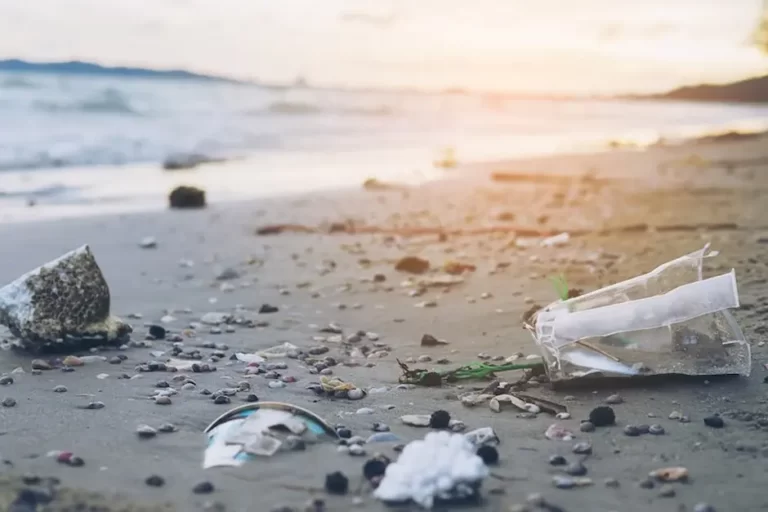Every year, millions of tons of plastic waste find their way into our oceans, posing a severe threat to marine ecosystems and biodiversity. But what happens to our plastic waste in the ocean? How does a plastic bottle discarded in a city park end up in the belly of a sea turtle thousands of miles away?
This blog post aims to unravel the journey of plastic waste from our homes to the vast, deep expanses of the ocean. We will delve into the impact of plastic pollution on marine life, explore the ominous phenomenon of microplastic accumulation, and discuss the potential health risks that this global issue presents to humans.
Join us as we navigate through the waves of this pressing environmental issue, understanding its causes, consequences, and potential solutions. The journey of plastic waste is a complex one, intertwined with our daily lives in ways we may not even realize. It’s time to unveil the truth behind the plastic menace lurking in our oceans.
Key Takeaways
- Plastic waste enters the ocean through various routes, including terrestrial sources, coastal pollution, and urban runoff.
- The scale of plastic pollution in the ocean is staggering, with microplastics posing a unique and significant threat to marine life.
- Plastic waste in the ocean depths, or the “deep-sea dilemma,” highlights the pervasive nature of plastic pollution and its ability to impact ecosystems far removed from human activity.
- Plastic pollution in the ocean can have significant impacts on human health, primarily through the consumption of seafood contaminated with microplastics and associated toxins.
- Plastic pollution has economic consequences, causing substantial financial losses for sectors that depend on clean and healthy oceans, such as tourism and fisheries.
- Addressing plastic pollution requires improving waste management practices globally, reducing the production of unnecessary plastic, and improving waste collection and recycling systems.
- Technology can play a significant role in tackling plastic pollution, with innovations like waste tracking systems and ocean cleanup technologies offering potential solutions.
- The future of our oceans depends on the actions we take today, highlighting the importance of individual and collective efforts in tackling plastic pollution.
The Journey of Plastic Waste to the Ocean
Plastic waste embarks on a long and perilous journey before it reaches the ocean. It starts innocently enough, perhaps as a discarded water bottle or a shopping bag blowing in the wind. However, these seemingly harmless items can become deadly pollutants when they enter our waterways.
Plastic waste can be transported to the ocean through various routes. Terrestrial sources, such as landfills and urban areas, contribute significantly to plastic pollution. Improper waste management practices can lead to plastic debris being carried away by wind or rain, eventually ending up in rivers and streams.
Coastal pollution is another major contributor. Activities such as recreational beach use and commercial shipping can lead to substantial amounts of plastic waste entering the ocean. Additionally, urban runoff, a form of pollution caused by rainwater picking up debris from city streets and carrying it into storm drains, can also lead to plastic waste entering our oceans.
The Scale of Plastic Pollution in the Ocean
The scale of plastic pollution in the ocean is staggering. It is estimated that up to 12 million metric tons of plastic enter our oceans each year. This plastic waste accumulates in five major ocean gyres, creating vast ‘garbage patches’ that pose a significant threat to marine life.
One of the most concerning aspects of plastic pollution is the creation and accumulation of microplastics. These tiny plastic fragments, less than 5mm in diameter, are either manufactured to be small (like those in certain cosmetics or industrial cleaners) or result from the breakdown of larger plastic items. Microplastics are particularly harmful as they are easily ingested by marine organisms and can even make their way up the food chain, potentially impacting human health.
The Impact of Plastic Waste on Marine Ecosystems
The presence of plastic waste in our oceans has far-reaching consequences for marine ecosystems. Plastic debris, both macro and micro, poses a significant threat to a wide range of marine species. From the smallest plankton to the largest whales, no creature is immune to the effects of plastic pollution.
Marine animals often mistake plastic debris for food. Sea turtles, for instance, can confuse floating plastic bags with jellyfish, one of their primary food sources. When ingested, these plastic items can cause blockages in the digestive system, leading to starvation and death. Similarly, seabirds, mistaking small plastic particles for fish eggs, can end up with stomachs full of plastic, leading to malnutrition and eventual death.
Microplastics present a unique challenge. Due to their small size, they can be ingested by a wide range of organisms, including small fish and zooplankton. Once ingested, microplastics can cause physical harm and also act as carriers for other pollutants, introducing harmful chemicals into the food chain.
The Deep-Sea Dilemma: Plastic Waste in the Ocean Depths
The impact of plastic waste is not limited to the ocean’s surface or coastal areas. Recent studies have found plastic debris in the deepest parts of the ocean, revealing a new dimension to the plastic pollution crisis.
Plastic waste can sink and accumulate in deep-sea environments, impacting species that live in these dark, cold habitats. The degradation process of plastic in these conditions is slow, leading to long-term contamination. The presence of plastic in these remote locations highlights the pervasive nature of plastic pollution and its ability to impact ecosystems far removed from human activity.
The Human Impact: From Oceanic Plastic Accumulation to Our Plates
The effects of plastic pollution in the ocean are not confined to marine life. There is a growing body of evidence suggesting that plastic waste in the ocean can also have significant impacts on human health.
As plastics break down into smaller pieces, they can absorb harmful chemicals from the surrounding environment. When marine organisms ingest these contaminated plastics, the toxins can accumulate in their tissues. Through the process of biomagnification, these toxins can make their way up the food chain, potentially ending up on our plates.
Consuming seafood contaminated with microplastics and associated toxins can lead to a range of health issues, including hormonal disruption and increased risk of certain cancers. Furthermore, plastic debris in the ocean can also act as a vector for invasive species and pathogens, posing additional risks to human health.
The Economic Consequences of Plastic Pollution
Beyond the environmental and health impacts, plastic pollution also has significant economic consequences. Marine litter can cause substantial financial losses for sectors that depend on clean and healthy oceans, such as tourism and fisheries.
Tourist destinations with littered beaches and polluted waters are less attractive to visitors, leading to decreased tourism revenue. Similarly, fisheries can suffer economic losses due to reduced fish stocks and damage to fishing equipment caused by plastic debris.
Addressing the Issue: Waste Management and Plastic Pollution
Addressing the issue of plastic pollution in our oceans requires a multi-faceted approach. At the heart of this is improving waste management practices globally. This includes reducing the production of unnecessary plastic, improving waste collection and recycling systems, and ensuring proper disposal of plastic waste.
Reducing our reliance on single-use plastics is a crucial first step. This can be achieved through changes in consumer behavior, such as choosing reusable items over disposable ones, and through legislation that bans or limits the use of certain single-use plastics.
Recycling plays a key role in managing plastic waste. However, for recycling to be effective, we need to improve collection systems and invest in recycling technologies that can handle different types of plastic.
In addition to these measures, cleaning up existing plastic waste in the ocean is also necessary. This can be achieved through large-scale clean-up operations and through the use of innovative technologies designed to remove plastic from the ocean.
The Role of Technology in Tackling Plastic Pollution
Technology can play a significant role in tackling plastic pollution. Innovations such as waste tracking systems can help improve waste management practices, while technologies designed to clean up plastic from the ocean can help reduce the amount of plastic waste in marine environments.
One such technology is The Ocean Cleanup, a project that aims to remove plastic from the Great Pacific Garbage Patch using a passive drifting system. Other technologies are being developed to prevent plastic waste from entering the ocean in the first place, such as trash wheels that remove waste from rivers.
Conclusion
The issue of plastic waste in our oceans is a global problem that requires global solutions. It’s a problem that affects us all, from the marine creatures that inhabit our oceans to the human populations that rely on them.
By understanding the journey of plastic waste from our homes to the ocean, we can begin to see the role we all play in this issue. It’s a daunting challenge, but by working together, we can make a difference. Whether it’s reducing our use of plastic, improving waste management practices, or supporting clean-up efforts, every action counts.
The future of our oceans depends on the actions we take today. Let’s make sure we make the right choices for a cleaner, healthier ocean.
Frequently Asked Questions (FAQs)
What are 5 consequences of plastic waste in the oceans?
-Marine life ingestion: Animals mistake plastic for food, leading to blockages in their digestive systems and potential starvation.
-Entanglement: Creatures can become trapped in larger pieces of plastic waste, leading to injury or death.
-Habitat disruption: Accumulated plastic waste can alter the physical environment, disrupting habitats for various species.
-Human health risks: Toxins from plastics can enter the food chain, potentially impacting human health when we consume affected seafood.
-Economic impact: Plastic pollution can negatively affect industries like tourism and fishing, leading to economic losses.
Is the plastic in the ocean from recycling?
Not all plastic waste in the ocean comes from recycling. In fact, a significant portion comes from improperly disposed of plastic that was not recycled. However, plastic that is not correctly recycled can end up in the ocean.
Who is dumping plastic in the ocean?
Plastic waste can enter the ocean through various sources. This includes improper waste disposal from individuals, businesses, and even some waste management services. It can also come from littering on beaches and land, and from fishing vessels that lose or discard plastic gear.
What happens to plastic waste when left in the environment?
Plastic waste does not decompose like organic material. Instead, it breaks down into smaller and smaller pieces over time, eventually becoming microplastics. These tiny particles can be ingested by wildlife and can carry toxins that harm marine life and potentially humans.

